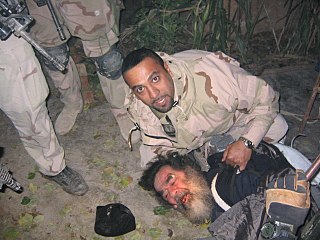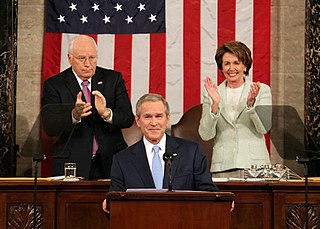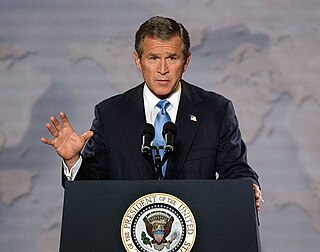
Saddam Hussein, the deposed president of Iraq, was captured by the United States military in the town of Ad-Dawr, Iraq on 13 December 2003. Codenamed Operation Red Dawn, this military operation was named after the 1984 American film Red Dawn.

The Iraq Liberation Act of 1998 is a United States Congressional statement of policy stating that "It should be the policy of the United States to support efforts to remove the regime headed by Saddam Hussein from power in Iraq." It was signed into law by President Bill Clinton, and states that it is the policy of the United States to support democratic movements within Iraq. The Act was cited in October 2002 to argue for the authorization of military force against Iraq.
The main event by far shaping the United States foreign policy during the presidency of George W. Bush (2001–2009) was the 9/11 terrorist attacks against the United States on September 11, 2001, and the subsequent war on terror. There was massive domestic and international support for destroying the attackers. With UN approval, US and NATO forces quickly invaded the attackers' base in Afghanistan and drove them out and the Taliban government that harbored them. It was the start of a 20-year quagmire that finally ended in failure with the withdrawal of United States troops from Afghanistan.
The following lists events in the year 2003 in Iraq.

The Saddam Hussein and al-Qaeda link allegations were based on false claims by the United States government alleging that a secretive relationship existed between Iraqi president Saddam Hussein and the Sunni pan-Islamist militant organization al-Qaeda between 1992 and 2003. U.S. president George W. Bush used it as a main reason for invading Iraq in 2003.

The White House Iraq Group was a working group of the White House set up in August 2002 and tasked with disseminating information supporting the positions of the George W. Bush administration relating to a possible invasion of Iraq, which would subsequently take place in March 2003.
The Saddam Hussein interview is a television interview hosted by American journalist Dan Rather with Iraqi president Saddam Hussein on February 24, 2003, very shortly before the 2003 invasion of Iraq. The interview was aired both in the United States and on all three Iraqi television networks. British politician Tony Benn had also interviewed Saddam earlier that month.

There are various rationales for the Iraq War that have been used to justify the 2003 invasion of Iraq and subsequent hostilities.

The 2006 State of the Union Address was given by the 43rd president of the United States, George W. Bush, on January 31, 2006, at 9:00 p.m. EST, in the chamber of the United States House of Representatives to the 109th United States Congress. It was Bush's fifth State of the Union Address and his sixth speech to a joint session of the United States Congress. Presiding over this joint session was the House speaker, Dennis Hastert, accompanied by Dick Cheney, the vice president, in his capacity as the president of the Senate.

The 2005 State of the Union Address was given by the 43rd president of the United States, George W. Bush, on February 2, 2005, at 9:00 p.m. EST, in the chamber of the United States House of Representatives to the 109th United States Congress. It was Bush's fourth State of the Union Address and his fifth speech to a joint session of the United States Congress. Presiding over this joint session was the House speaker, Dennis Hastert, accompanied by Dick Cheney, the vice president, in his capacity as the president of the Senate.
The response to the 2006 State of the Union Address was delivered by Virginia Governor Tim Kaine on January 31, 2006, after United States President George W. Bush delivered his 2006 State of the Union address. The theme of Kaine's speech, "A Better Way", advocates the Democratic Party's policies and states' rights. Kaine delivered the speech from Virginia's historic Executive Mansion in Richmond and the speech was televised nationwide.
The 2003 United States–British–Spanish Draft Resolution on Iraq was, according to Ambassador John Negroponte, "a resolution to have the Council decide that Iraq is not complying, is out of compliance, with Resolution 1441". Initially introduced on February 24, 2003, and amended on March 7, 2003, the draft set a March 17 deadline for Iraq to demonstrate "full, unconditional, immediate and active cooperation in accordance with its disarmament obligations." The draft was based on information from the Iraqi defector "Curveball," who claimed Saddam Hussein was in possession of weapons of mass destruction, which Curveball later admitted was untrue. The widely discussed UN resolution was not brought up for formal vote after it became clear that it would not have passed due to opposition from France, Russia, and China. The United States invaded Iraq without UN support on March 20, 2003, initiating the Iraq War.

The 2007 State of the Union Address was given by the 43rd president of the United States, George W. Bush, on January 23, 2007, at 9:00 p.m. EST, in the chamber of the United States House of Representatives to the 110th United States Congress. It was Bush's sixth State of the Union Address and his seventh speech to a joint session of the United States Congress. Presiding over this joint session was the House speaker, Nancy Pelosi, accompanied by Dick Cheney, the vice president, in his capacity as the president of the Senate.

The 2004 State of the Union Address was given by the 43rd president of the United States, George W. Bush, on January 20, 2004, at 9:00 p.m. EST, in the chamber of the United States House of Representatives to the 108th United States Congress. It was Bush's third State of the Union Address and his fourth speech to a joint session of the United States Congress. Presiding over this joint session was the House speaker, Dennis Hastert, accompanied by Dick Cheney, the vice president, in his capacity as the president of the Senate.

The 2002 State of the Union Address was given by the 43rd president of the United States, George W. Bush, on January 29, 2002, at 9:00 p.m. EST, in the chamber of the United States House of Representatives to the 107th United States Congress. It was Bush's first State of the Union Address and his second speech to a joint session of the United States Congress. Presiding over this joint session was the House speaker, Dennis Hastert, accompanied by Dick Cheney, the vice president, in his capacity as the president of the Senate.

The 2008 State of the Union Address was given by the 43rd president of the United States, George W. Bush, on January 28, 2008, at 9:00 p.m. EST, in the chamber of the United States House of Representatives to the 110th United States Congress. It was Bush's seventh and final State of the Union Address and his eighth and final speech to a joint session of the United States Congress. Presiding over this joint session was the House speaker, Nancy Pelosi, accompanied by Dick Cheney, the vice president, in his capacity as the president of the Senate.
The Habbush letter, or Habbush memo, is a handwritten message dated July 1, 2001, which appears to show a link between al-Qaeda and Iraq's government. It purports to be a direct communication between the head of Iraqi Intelligence, General Tahir Jalil Habbush al-Tikriti, to Iraqi president Saddam Hussein, outlining mission training which Mohamed Atta, one of the organizers of the September 11 attacks, supposedly received in Iraq. The letter also claims that Hussein accepted a shipment from Niger, an apparent reference to an alleged uranium acquisition attempt that U.S. President George W. Bush cited in his January 2003 State of the Union address.

Prior to the Iraq War, the United States accused Iraq of developing weapons of mass destruction and having links with al-Qaeda. In 1991, the United Nations Security Council Resolution 687 was adopted and subsequent UN weapons inspectors were inside Iraq. This period also saw low-level hostilities between Iraq and the United States-led coalition from 1991–2003.
The timeline of the Gulf War details the dates of the major events of the 1990–1991 war. It began with the Iraqi invasion of Kuwait on 2 August 1990 and ended with the Liberation of Kuwait by Coalition forces. Iraq subsequently agreed to the United Nations' demands on 28 February 1991. The ground war officially concluded with the signing of the armistice on 11 April 1991. However, the official end to Operation Desert Storm did not occur until sometime between 1996 - 1998. Major events in the aftermath include anti-Saddam Hussein uprisings in Iraq, massacres against the Kurds by the regime, Iraq formally recognizing the sovereignty of Kuwait in 1994, and eventually ending its cooperation with the United Nations Special Commission in 1998.
The following is a timeline of the presidency of George W. Bush, from January 1, 2003, to December 31, 2003.














